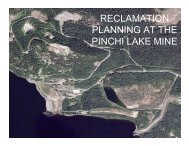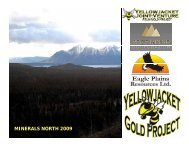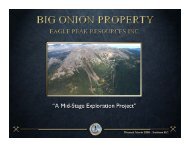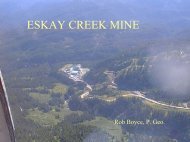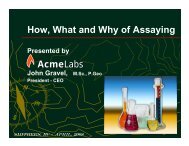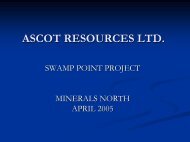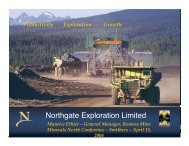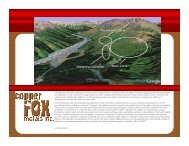Chinese Coins James Mooney MN 2012.pdf - Minerals North
Chinese Coins James Mooney MN 2012.pdf - Minerals North
Chinese Coins James Mooney MN 2012.pdf - Minerals North
You also want an ePaper? Increase the reach of your titles
YUMPU automatically turns print PDFs into web optimized ePapers that Google loves.
<strong>James</strong> <strong>Mooney</strong>, MA, RPCAEcofor Consulting Ltd.Whitehorse, Yukon(867) 668-6600
<strong>Chinese</strong> Cast CoinManufacturing and Dating• <strong>Coins</strong> manufactured during Ming and ChingDynasties used “mother” coins made of tin and softmetals as original positives.• Mother coins were set in series of hard packed, finegrained sand, sprinkled with fine coal or charcoal dustas flux.• Made a “tree” of 50 to 100 coins per cast level in tightlywrapped wood frames of multiple levels.• Mass production – approximately 2 billion coins madejust in 1600s.
China – Yukon Trade Interaction• Methods by which coins could have reached SEAlaskan and NW Coast of BC then into the Yukon.• “Drift-iron” from very early shipwrecks carry metal toshore. First recorded shipwrecks in the mid 1700s butmore were likely prior to these.• Possible shipwreck debris moving from <strong>North</strong>westPacific to SE Alaska, NW BC in Kuroshio (BlackStream) Japanese current.• Example: 1916 - damaged Japanese fishing boat driftsacross Pacific Ocean to Haida Gwaii in 24 days.
China – Yukon Trade Interaction
China – Yukon Trade Interaction• Early 1700s Peter the Great orders exploration fromKamchatka to America .• 1728 - Vitus Bering first attempt “fails”• 1741 – Bering and opens up Sea Otter trade andpromyshlenniki (private traders) follow.• 1762 Russian trading reaches Kodiak Island andeastern Alaska. Sea otter pelts to China – massproduced goods going back to America.• Late 1790s Russian American Company is tradingdirectly with Coastal Chilkat Tlingit.
China – Yukon Trade Interaction
First Nation and early historicuse of <strong>Chinese</strong> <strong>Coins</strong>• As coins leave China there is little to no evidence ofthem being used as currency outside of China.• First Nation & aboriginal use is primarily decoration –seen in clothing, personal accessories, masks, warvests, dance vests, some in Tlingit warrior’s chestarmour.• <strong>Chinese</strong> immigrant use of coins as gaming pieces (fant’an), good luck tokens, amulets, medicinal purposes“coin-swords”, charms to ward off evil spirits.• Early <strong>Chinese</strong> people in and near the Yukon?
Early <strong>Chinese</strong> Immigration tothe Yukon and NW BC• 1788 – 50 <strong>Chinese</strong> artisans arrive on Vancouver Islandwith Capt. John Meares to build trading post.• 1858 - Asian prospectors arrive in BC followingAmerican gold rushes.• <strong>Chinese</strong> move north with BC gold rushes: Fraser River,Barkerville, Germansen Landing., Manson Creek• 1870s – Cassiar gold rush 1/3 of men were <strong>Chinese</strong>.• 1880s – 15,000 <strong>Chinese</strong> labourers arrive in BC to buildrailroad.
Early <strong>Chinese</strong> Immigration tothe Yukon and NW BC• By 1885 views of <strong>Chinese</strong> and Asians changed to thepoint of Federal anti-Asian policy.• 1885 – Federal head tax of $50 imposed.• 1898 – Klondike Gold Rush – Skagway anti-Asiangroups turn back <strong>Chinese</strong> and Japanese.• Early mineral exploration in NW BC and SW Yukonduring gold rush may have included <strong>Chinese</strong>.• Very few <strong>Chinese</strong> get into Yukon – some work forWPYR – cooks, mess attendants, laundry workers.
Early <strong>Chinese</strong> Immigration tothe Yukon and NW BC• 1898 some Japanese placer miners were recorded inDawson area but no records yet of <strong>Chinese</strong> placer orhard rock miners in Yukon (research pending).• 1900 Federal head tax increased to $100.• 1902 Japanese and <strong>Chinese</strong> immigrants turned away inWhitehorse and sent back to Skagway.• 1903 Federal head tax on <strong>Chinese</strong> increased to $500.• 1923 <strong>Chinese</strong> Immigration Act prevented all <strong>Chinese</strong>except consuls, merchants, and students, fromentering Canada.
<strong>Coins</strong> foundin and near theYukon:1) Freegold Road2) Beaver Creek3) Marsh Lake4) Fantail River, BC5) Fantail River, BC
Freegold Road• Minted during reign oflongest serving <strong>Chinese</strong>Emperor Sheng Zu (1662-1722 AD). Inscription onobverse reads Kang Xi tong bao ( 康 熙 通 宝 ), meaningcurrency of Kang Xi.• Reverse shows xuanhua ( 宣 化 ) garrison which waslocated in what was then called Zhili ( 直 隶 ) Province(now Hebei Province) roughly 300 kilometressouthwest of what is now the capital of China. Thisgarrison only minted coins between 1667 and 1671.
Freegold Road• Four smaller holes may beresult of tacking into woodor stitching into clothing.• Small impressions mayindicate tack or nail head.• Possible Tlingit armour use?• Possibly traded into interior near Chilkat Tlingit Trailbetween Ft. Selkirk and Dyea, Alaska.• Tlingit controlled trade to interior – sacked Ft. Selkirkin 1852 when Robert Campbell tried to improve fort.
Beaver Creek• Inscription on obversereads Yong Le tong bao( 永 樂 通 寶 ) during the regind of Emperor Cheng Zu ofthe Ming Dynasty (A.D. 1403-1424).• No inscriptions on reverse but has a curved dent in theedge – possible musket ball impact?• Shortage of copper – minted between 1408 and 1424.• Could have been minted in Beijing*, Nanking on eastcoast, or at one of the early provincial mints.
Beaver Creek• May have been traded infrom early Russian tradingfrom Dry Bay or Yakutat Bay by Coastal Tlingit.• May have been carried in by <strong>Chinese</strong> placer minersduring the Klondike or Chisana gold rushes.• Perhaps associated with Cordova to Kennicott rail roadworkers 1907 – 1911 about 100 km to the southwest?• Also possible one or two pig bone fragments found insame site.
Marsh Lake• The inscription on theobverse reads YongZheng tong bao ( 雍 正 通 寶 ) and was made during thereign of Emperor Shi Zong (A.D. 1723-1735).• Cast at the Zhanyi mint in Yunnan Province between1724 - 1727 in southern China and may have beenmoved by British traders.• Perhaps moved by <strong>Chinese</strong> labourers or prospectorsduring early Klondike era and exploration of MarshLake in early 1900s along the Livingston Trail?
Fantail River• Collected near TagishLake along Fantail Riverwhich was the focus ofmineral exploration inthe early 1900s.• Both minted during thereign of Kang Xi (Kangxi 康 熙 ) between 1702 – 1713.• Minted at Board of Revenue mint which is located justnortheast of Tiananmen Square in Beijing.
Before you Explore…Call Ecofor(250) 996-2151(867) 668-6600




